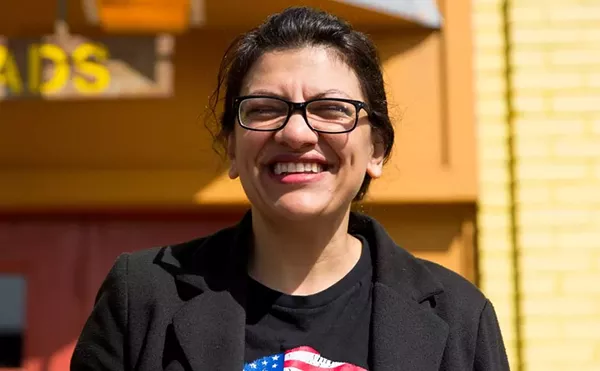As he grew up, "Dixie" Dave Minar hunted, fished and learned how to cook his prey, developing a taste for wild game. Venison and pheasant and other locally available meats weren't enough for him, so he expanded his appetite for the unusual, eventually opening a restaurant in Birch Run that's known for its variety of game. Dixie Dave also wrote a cookbook teaching hunters and gourmands how to explore their interest in cooking game at home.
METRO TIMES: Where did you get your interest in game cooking?
DAVE MINAR: I grew up on a farm. Us boys brought everything home: muskrats, woodchucks, possums, pheasants, coons, squirrels — you name it. My grandmother was a fabulous cook. She did just an unbelievable job cooking game. My whole family was hunters. We traveled out West elk hunting. We went antelope hunting and pheasant hunting. I carried that love of the outdoors in cooking through my life until I wanted to be a professional chef in the '60s. So when I opened my first restaurant in Florida, I had some crazy stuff on the menu, whatever I could get. Back then you could get frog legs from the Everglades. You could get gator from the Seminole Indians. I had a supply for pheasant, so I always had that on my menu. When I came back, it was a lot easier to find game in Michigan. We started out with venison, buffalo, elk and pheasant, whatever we could get. Back in 1990, there was a TV show called Mike Avery's Outdoor Magazine. He needed a wild game chef on his show. He approached me and we decided to give it a try. We'd say on the show to send a self-addressed envelope, and we will send you the recipe. So the first show I did a bourbon cinnamon-glazed goose for the Christmas show. We got 300 requests for the recipe. The next show that we did, we got 500 requests for a pheasant recipe. As a result we have this book, Dixie Dave's Wild Game Recipes that has about 180 recipes.
MT: Where do you source all of the stuff that's on your menu?
MINAR: Game has to be farm-raised. Well, not all of it. The wild boar is free-ranged in Texas. They trap 'em down there. It's actually a feral hog, so it's a wild hog. The pheasant we use is from Freemont and they do raise them in large flight pens. That's the only animal, I think, that has antibiotics in it. And the game we use, the buffalo comes from South Dakota, and that's free-range, grass-fed. The alligator is from Coastal Procurement out of Louisiana, and that's wild gator. The elk and venison is free-range from New Zealand, all grass-finished. There's not a lot of saturated fat in the meat of animals that are grass-finished.
MT: You have seafood too? Where do you get it?
MINAR: The fisherman. When you buy farm-raised fish such as catfish and tilapia, that has tetracycline in the water. That keeps the bacteria problems down. That's why they can raise farm-raised shrimp and all of these other things in such huge quantities in a small amount of water without them catching disease. But that actually passes on to the people who are eating it. We use absolutely no farm-raised fish at the restaurant, wild-caught only.
MT: Can you serve game that you've shot yourself or does it have to be controlled for health and safety reasons?
MINAR: What we have to do in the restaurant business is buy from a reputable dealer. That includes fish too. You can't go fishing and catch perch or salmon and use it. And you just can't go out and shoot deer or pick up roadkill. It has to come from state-certified sources, as well as produce. People are always trying to bring me morels and other mushrooms, but there has to be a paper trail. If somebody was to get ill, you'd have to find out where it came from.
MT: What abut bear? I've heard that it's delicious.
MINAR: Bear is really, really good. I have two different companies that raise bear strictly for the restaurant business. We sell a lot of bear in the winter. I get African lion and bear out of Chicago.
MT: African lion? How do you cook that? Isn't it tough? (No pun intended.)
MINAR: No, no. African lion is really tender. Lion is one of them things we get out of Chicago with zebra and some other crazy stuff. They get the meat from private collectors and zoos. Everybody wants to see the cutesy little baby animals. So what do you do with the ones that are a year old and the mother comes back and gives birth to the ones that everybody at the zoos want to see? So they go to this place in Chicago where they get doled out to the restaurants.
MT: Are there any other unusual animals that you've served?
MINAR: We've served rattlesnake, boa constrictor, cobra, kangaroo. Alligator's pretty mundane anymore. Bobcat we've had. Beaver in Burgundy is one of my favorites. We sell a beaver and barley soup.
MT: Does your restaurant in Birch Run serve mostly game or is it a bar that serves burgers and occasionally an elk steak?
MINAR: About 40 percent of what we sell is wild game. We're a white-tablecloth establishment. We have a nice selection of wine and Champagne, a full bar. You can get a hamburger, though, or a char-grilled buffalo burger. A lot of people have had game and they say it's horrible. When they come to the restaurant, they see what a professional chef can do with game. When they have an elk steak cooked medium rare and embellished with a great sauce, then they're hooked on it and we'll see them time and time again.
Dixie Dave's Wild Game Recipes cookbook is available at his restaurant, the Old Dixie Inn in Birch Run, Mich., or online at dixiedave.com. Dave will be appearing and doing cooking demos at the Outdoorama and Cottage Lake Living Show at Novi's Rock Financial Showplace Feb. 26-March 1.
Walleye New Orleans
Serves 4
6-8 ounces boneless, skinless fillet per person
1 can artichoke hearts, drained and quartered
12 ounces fresh mushrooms, sliced thin
1/3 cup onions, diced medium
2 eggs, beaten well
1 cup flour
1/2 stick butter
1-1/2 cups dry white wine
1 tablespoon fresh parsley, chopped
juice of one lemon
Dredge fillets in flour and dip in beaten eggs. Add oil to coat bottom of very hot pan. Place fillets skin side up in pan. Do not crowd. Brown on both sides.
Add wine, mushrooms, onions, butter, artichoke hearts and lemon juice. Uncovered, reduce volume over high heat until thick and creamy.
Place fillets on warm plates. Spoon sauce equally over each fillet and sprinkle with parsley.
Jeff Broder does this monthly food interview for Metro Times. Send comments to [email protected]





